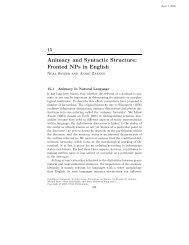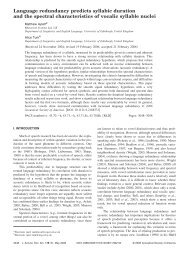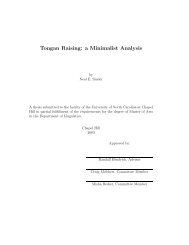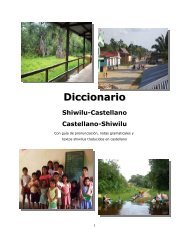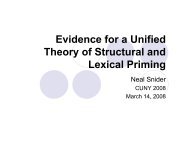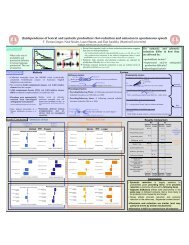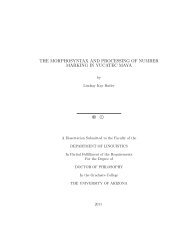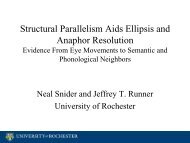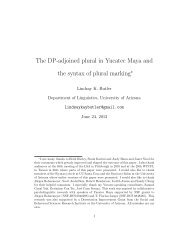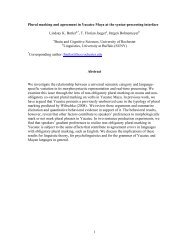Weak definite noun phrases: rich, but not strong, special, but not ...
Weak definite noun phrases: rich, but not strong, special, but not ...
Weak definite noun phrases: rich, but not strong, special, but not ...
You also want an ePaper? Increase the reach of your titles
YUMPU automatically turns print PDFs into web optimized ePapers that Google loves.
3.2 Experiment 2Figure 3: Experiment 2, One Token and Two TokenThe results of Experiment 1 indicate that weak <<strong>strong</strong>>definite</<strong>strong</strong>>s do <<strong>strong</strong>>not</<strong>strong</strong>> presuppose the uniqueness of theirreferent. This raises the possibility that weak <<strong>strong</strong>>definite</<strong>strong</strong>>s are in<<strong>strong</strong>>definite</<strong>strong</strong>>s masquerading as <<strong>strong</strong>>definite</<strong>strong</strong>>s,and that they therefore serve to establish new discourse referents rather than to refer to old ones.Experiment 2 tests this claim in a scene verification task that assesses the acceptability of sentence/picturepairs 6 . Sentences such as (10) and (11) below contain either a weak or regular <<strong>strong</strong>>noun</<strong>strong</strong>>paired with either the <<strong>strong</strong>>definite</<strong>strong</strong>> or in<<strong>strong</strong>>definite</<strong>strong</strong>> article. The conjoined-NP form of the sentences waschosen in order to emphasize the simultaneity of the described activities, so that participants would<<strong>strong</strong>>not</<strong>strong</strong>> be confused by seeing both individuals depicted in the same picture. Pictures crucially showeither one or two tokens of the critical <<strong>strong</strong>>noun</<strong>strong</strong>> (e.g. bike or bus). Examples are shown in Fig. 3.(10) Dean and Anne rode a/the bike.(11) Jerome and Sandy rode a/the bus.Scenes and sentences were presented simultaneously on a computer monitor. Thirty-three participantswere instructed to rate the appropriateness of the written descriptions for each pictureon a seven-point scale, with seven being the most appropriate. Two participants were excludedfor reversing the scale, as evidenced in their filler ratings. If the critical NP prefers to establish adiscourse entity, two-referent scenes should be rated as less appropriate (compared to one-referentscenes), since the number of entities in the discourse will <<strong>strong</strong>>not</<strong>strong</strong>> match the number of referents in thescene. If, however, the NP does <<strong>strong</strong>>not</<strong>strong</strong>> serve to establish a discourse entity, this numerical mismatchof referents will <<strong>strong</strong>>not</<strong>strong</strong>> exist, and participants will accept two- as well as one-referent scenes.As expected, when only one token of the critical <<strong>strong</strong>>noun</<strong>strong</strong>> was pictured, all descriptions were ratedas being highly appropriate (average of 6 or higher). The difference in ratings between one tokenand two token conditions is significant, as shown in Table 1.Thus we focused our analysis on the trials containing pictures with two depicted tokens of the<<strong>strong</strong>>noun</<strong>strong</strong>>. For these items, the weak <<strong>strong</strong>>definite</<strong>strong</strong>> NPs (rode the bus) had the highest average acceptabilityHowever, first-pass analysis shows a pattern consistent with the behavioral data; when we measure the proportion ofeye-fixations during the region including the repetition of the <<strong>strong</strong>>noun</<strong>strong</strong>> and the word immediately following, when peopleare looking at the old token of the <<strong>strong</strong>>noun</<strong>strong</strong>> they are more likely to have heard a regular <<strong>strong</strong>>definite</<strong>strong</strong>>, and when they arelooking at the new token they are more likely to have heard a weak <<strong>strong</strong>>definite</<strong>strong</strong>>.6 Comparing weak <<strong>strong</strong>>definite</<strong>strong</strong>>s to in<<strong>strong</strong>>definite</<strong>strong</strong>>s using the methodology from Experiment 1 proved to be too difficult giventhe very subtle nature of the phonetic difference between the two unstressed articles in our recordings6



